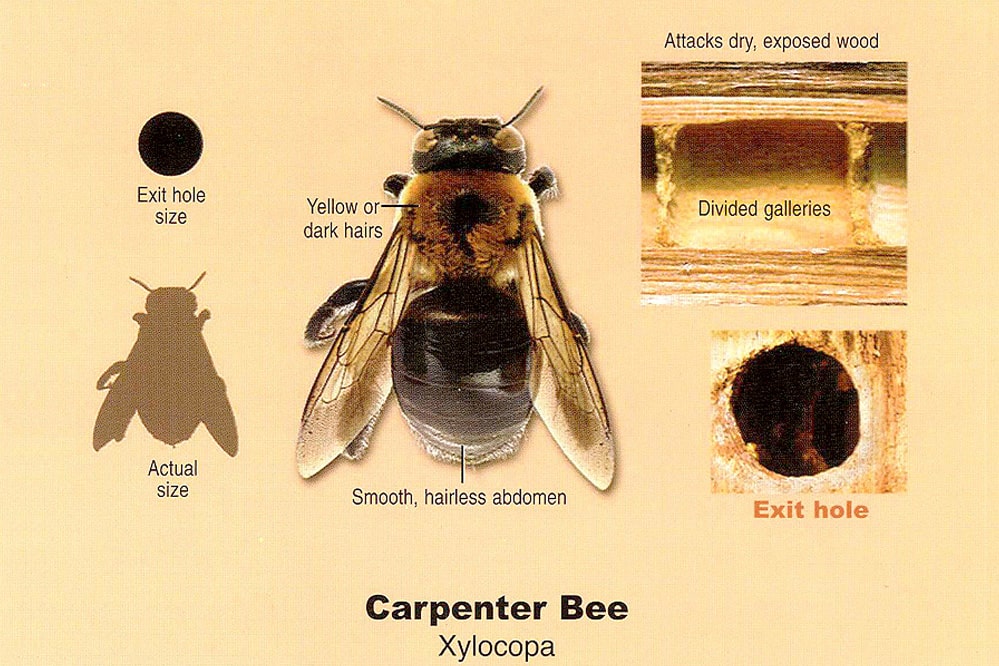Carpenter Bees are a common problem for owners of log homes and controlling them is an even bigger challenge. Most people know very little about carpenter bees and are even intimidated by these intruders. This is a guide for log home owners to deal with carpenter bee problems. Information about Carpenter Bees You must first know a little more about carpenter bees before trying to effectively deal with them. Carpenter bees live throughout the United States, though the western species of carpenter bees prefer to nest in oak, eucalyptus, and redwood. Eastern species will target pine, redwood, fir, and cedar. To a carpenter bee therefore, a log home is the ideal target, with unpainted and weathered soft woods like redwood, pine, and cedar.
These are solitary bees that do not live in hives. They are often mistaken for bumble bees, but unlike them carpenter bees have bare shiny backs. The male carpenter bee has white head markings, and is the most visible of the species. Aggressive, they often hover in front of people who approach their nest, but males are incapable of stinging and pose no risk when encountered. The more passive female is capable of inflicting a painful sting when provoked, and can be identified by their unmarked, black heads.
The main complaint about carpenter bees is the round holes they drill into logs, fascia boards, eaves, decks and other unpainted wood surfaces. Carpenter bees do not eat wood; they only drill into it for nesting purposes. Twice a year, in the spring and fall, log homes are invaded by these insects. In early spring male and female bees emerge after spending the winter in old nest tunnels and once they mate, the female bee drills into a suitable nesting site while the male stays nearby to ward off intruders. After the initial hole is drilled through the surface, the bee makes a ninety degree turn to excavate a tunnel along the grain of the wood. This tunnel, which may run for several inches, becomes the nesting site to deposit her eggs. Several eggs are laid in individual chambers separated by plugs of pollen on which the larvae feed until they emerge as adults. In addition to making new holes, carpenter bees keep enlarging old tunnels and if left unattended for several years, serious damage to the wood structure may result. In late fall, activity may again be seen as both male and female carpenter bees clean out old cavities, where they stay over winter.
What is the Damage caused by Carpenter Bees?
- Re-infestation, nest expansion causes wood structure damage if left unattended.
- Siding and other thin wood can be completely penetrated leading to possible rot and moisture problems.
- Carpenter bees drill holes that allow wood-boring insects and woodpeckers, to wreak havoc on your home. Woodpeckers peck even larger holes into the log or siding of your home, in order to eat carpenter bees and their larvae.
Control and Prevention There is no easy way to control carpenter bees from making nests in your log home but certain preventive measure can be adopted. Corrective steps have to be taken to prevent long term damage.
- Paint Wood Surface
Carpenter bees prefer bare wood but they also will attack wood that is stained. Painted wood surfaces, on the other hand, are less frequently attacked since the bees must see or feel the grain of the wood in order to recognize it as wood. While wood stains may not deter carpenter bees, any exterior finishes with oil or polyurethane bases will also help.
- Use Insecticide or Borate Dust
To control existing carpenter bee populations, each nest site must be found and individually treated with preventative insecticide or borate additive. Each spring, start early, plan on spraying the exterior of your log home with an insecticide. Insecticides and borate additives are generally mixed in with stains or top coats to prevent insects from initially damaging the home.
- Spray Pesticide
Carpenter bees may be deterred from chewing into wood by spraying pesticides since carpenter bees appear to be sensitive to certain odors and tastes. However, the bees do not ingest wood so any pesticides that are applied may not be as effective. Also, the effectiveness of these applications is only about 7 to 14 days, so the treatment has to be repeated ever so often. These products should only be used during the periods of peak activity in the spring and perhaps again in late fall.
- Caulk and Treat Bee Holes
One of the most effective measures for preventing carpenter bees from boring into your log home is to first treat the existing bee holes with insecticide to kill the bees and then filling the holes with wood putty or caulk. The holes are first treated and then left unsealed so that any carpenter bees that enter the holes within the next couple weeks will be exterminated. Then the existing holes are sealed with a wood caulking product. While existing damage should be treated and sealed, a preventative solution to carpenter bee control includes adding a contact insecticide to the final coat of stain or acrylic top coat when re-staining or re-coating your home. Read and follow all product label and manufacturer’s instructions, as caution must be exercised when working with any type of hazardous insecticide. The key to carpenter bee control is not just in the methods you use but also knowing how and when to use it, so consider taking assistance from your local log home maintenance professionals. Read this article and still worried about bees invading your log home? Why not give us a call at 800-781-2551. Performance Log has years of experience at treating insect damage to log homes.


